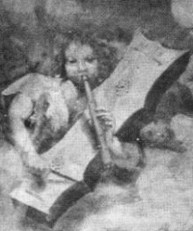- Psalterium (instrument)
Infobox Instrument
name=Psalterium
names=
classification=String instrument
range=Drone (music)
related=Hammered dulcimer , Tabor,Psaltery ,Zither ,Aeolian harp
articles=Psalterium or
Tambourin a chordes is a stringed musical instrument, and means the same thing aspsaltery . In specific usage, this name denotes a form of long psaltery that is tuned to provide drone chords. Sometimes called a string drum, it is usually used as rhythm accompaniment with a form oftabor pipe . [cite web | url = http://www.wood-n-bone.co.nz/musical_instruments.html | title = Musical Instruments | publisher = Wood-n-Bone | accessdate = 2008-01-29] It is also known as "tambourin de Béarn" [cite web | url = http://www.wood-n-bone.co.nz/musical_instruments.html | title = Musical Instruments | publisher = Wood-n-Bone | accessdate = 2008-01-29] in French, "ttun-ttun" (IPA: /cun'cun/, named after the sound emitted) in Basque or "chicotén" inAragonese . Some authors have called into question the inclusion of the Pyrenean stringed drum under the name of psalterium [cite web | url = http://www.euskomedia.org/PDFAnlt/riev/26567577.pdf | title =Some notes on the Pyrenean Stringed Drum with five musical examples | publisher = Euskonews&Media | accessdate = 2008-01-29] .Method
It is slung on the arm or over the shoulder of a player who uses the same hand to play the pipe, while striking the strings with a linen covered stick held in the other hand. The 6 strings (3 sets) are most often tuned in octaves that match the keynote of the
Tabor pipe , such as Cc Cc Cc or Dd Dd Dd etc. This musical percussion is quite pleasant and can be played pianisimo as well as forte'.Extent and uses
The instrument is currently widespread in the western
Pyrenees , and it bears the hallmark of the territory. Apparently invented in the 15th century, it came into use in the Pyrenees, where it took hold [cite web | url = http://rythmes-croises.org/ethnotempos/articles/mixel_etxekopar.htm | title = Mixel ETXEKOPAR & François ROSSÉ Une certaine Soule musique | publisher = ETHNOTEMPOS | accessdate = 2008-01-28 Article in French] . It is popular in the easternmost Basque county ofSoule (Zuberoa), where it provides along with the three hole flute (xirula ) the necessarymusical background for traditional dance performances and the carnival set of performances called "maskarada", which takes place on a yearly basis in different villages of the county [cite web | url = http://www.geocities.com/Paris/Cafe/1313/instrume.htm | title = Instruments de la Música Tradicional Basca | publisher = de bat a | accessdate = 2008-01-28 Article in Catalan] .After losing ground during the 20th century in western and central Pyrenees, namely Bigorre, Béarn and Soule, the practice of the three hole flute and tambourin came almost to a halt after World War II, except for the Ossau Valley in Béarn [cite web | url = http://www.sondaqui.com/cms/index.php?option=com_content&task=view&id=67&Itemid=111&&lang=FR | title = Flutes et Tambourin de Cordes, Flabutas et Tamborin | publisher = Son d'Aquí | accessdate = 2008-01-28 Article in French] . Evidence has been gathered also that with different names (such as "salterio") it was played along with the flute early in the 20th century in small areas of Alto Aragón [cite web | url = http://www.euskomedia.org/PDFAnlt/riev/26567577.pdf | title =Some notes on the Pyrenean Stringed Drum with five musical examples | publisher = Euskonews&Media | accessdate = 2008-01-29] . From the 1970's on, the instrument has shown renewed vitality.
Construction
It is a very simple form of psaltery or box zither, made of a wooden sounding box, with strings stretched from end to end, lengthwise. Its construction is similar to that of the
Aeolian harp orAppalachian dulcimer . The Pyrenean version of the instrument numbers 4 to 10 strings but 3 sets of 2 (6 total) is the common arrangement.ee also
*
Psaltery
*Pipe and Tabor
*Hammered dulcimer
*Guitar zither External links
* [http://www.es-aqui.com/payno/inst/chicoten.htm How to build a psalterium.]
* [http://www.youtube.com/watch?v=EGwyzpVQTq8 Ttun-ttun performance featured by M.Etxekopar]References
Wikimedia Foundation. 2010.
